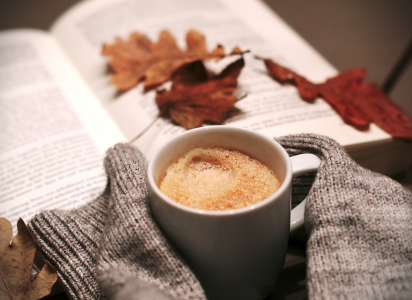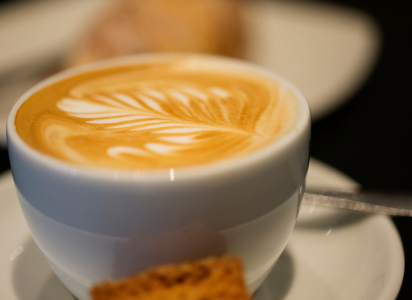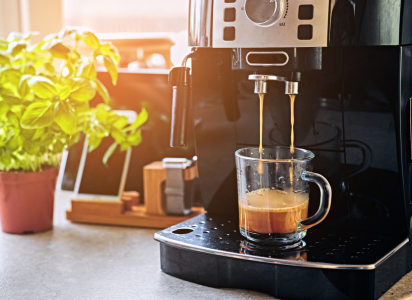There are different types of coffee drinkers. Some just buy whatever is on sale at the grocery store and others hurriedly run into the gas station for their morning coffee on the way to work.
Neither of these two types particularly cares about which coffee beans are used for their blend, or how the beans were roasted, etc. They just need their coffee craving resolved as soon as possible.
On the other hand, you may be a coffee connoisseur who takes it seriously, has knowledge about coffee, and its various styles. You take an extra, more mature step when it comes to your favorite beverage. This would mean that you are already familiar with flat white coffee. If not, your time has arrived.
In this post we’ll be taking a dive into the world of flat whites – where they come from and how to make one at home – so that you can be better informed and sip on a delicious beverage whenever the craving strikes.
So, What Is Flat White Coffee and Where Did It Originate?

Well, imagine a rich, creamy, and velvety espresso-based drink (an espresso is a concentrated form of coffee served in small, strong shots) that’s topped off with a silky layer of steamed milk. That’s essentially what you get with a flat white.
Originating from Australia and New Zealand, this popular specialty coffee has gained popularity worldwide in recent years. It’s a reportedly easier drink to make than a cappuccino and has a more velvety texture with a lower milk-to-coffee ratio.
The New Zealand claim originated at a cafe in Wellington and supposedly resulted from a cappuccino being made incorrectly. Either way, word of the beverage spread to the UK around 2005, and Starbucks added it to the menu in England in 2010.
Flat white coffee made it to America in 2013, appearing at Australian cafes in New York City. Starbucks added it to the menu in its American franchises in January of 2015.
Key Differences Between a Flat White and Other Drinks
The key difference between a flat white and some other espresso-based drinks lies in the texturing of the milk. In a flat white, the milk is steamed to a microfoam consistency, which means that it’s smooth and creamy, without much foam or froth. This gives the drink a deliciously silky texture and a rich, creamy mouthfeel that many coffee aficionados love. So if you’re looking for a coffee that’s not too strong but still has plenty of flavor, a flat white might be just what you’re after!
So, if you’re looking for a smoother alternative to a traditional latte or cappuccino, why not give a flat white a try?
Key Difference Between a Cappuccino and a Flat White
The difference is in the composition. It’s time to put on your connoisseur hat to explore a bolder taste with your coffee. A flat white starts with shots of espresso, but the main difference is in using refined micro-foamed milk, which provides a luscious, velvety texture. It doesn’t leave a foamy top, and the milk runs through the coffee.
A cappuccino is made with much bigger bubbles, creating a dryer foam that sits on top of your coffee. Some people call a flat white a “wet cappuccino”.
Key Difference Between a Latte and a Flat White
Let me break it down for you. Both drinks contain espresso and steamed milk but the ratio and texture are what set them apart.
A latte typically has more milk and a layer of foam on top, making it creamier, richer, and smoother. On the other hand, a flat white has less milk and a thin layer of micro-foam, giving it a stronger espresso flavor and a velvety texture that is just right.
Both are super delicious and you should definitely try both to see which one you prefer. If you want a richer, smooth taste, then a latte might be for you. However, if you prefer a richer “coffee” taste than a milder one, then try a flat white coffee. You won’t regret either!
How To Create Proper Micro-foam For A Flat White

This is a skill that takes some practice, and coffee aficionados really appreciate the effort and results. The idea might have been started by fancy baristas experimenting with “latte art”, while creating designs of various thickness floating on top of the coffee.
To create a microfoam, hot air is infused in the milk, with the steamer high up in the jug. The texture is then added to the milk by positioning the tip lower in the jug, which creates a whirlpool effect. The perfect texture for a flat white can be achieved with practice.
How to Make Your Own Perfectly Balanced Flat White Coffee at Home

If you’re looking to step up your at-home coffee game, a perfectly balanced flat white might just be the answer. In fact, during the winter, it is one of my favourite drinks to make at home.
To make your own, start with the right equipment: a milk frother or steamer, a scale for precise measurements, and a good-quality espresso maker.
This next part is the key to a delicious flat white: finding the perfect ratio of espresso and steamed milk!
For a standard 6-ounce cup, use a double shot of espresso (around 2 ounces) and top with around 4 ounces of steamed milk. The milk should be silky and smooth without any visible bubbles, and the espresso should be strong and bold.
Add a latte art design on top for a fancy touch, sit back, and enjoy your homemade flat white. Since I’m not gifted in the “latte art design”, I carve a little heart or my initial for some fun.
Now You Know!
From start to finish, the Flat White is a unique beverage with a rich and flavorful history. Not only has its heritage come from different places, but the way it’s made also varies depending on where you are in the world.
While some may find that a flat white more closely resembles that of a cappuccino or latte, its differences lie in the amount and type of milk used. Whether you choose to enjoy this specialty coffee at your favorite café or make one yourself in the comfort of your home – don’t forget to appreciate all the elements that makes it so special and delicious!